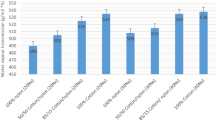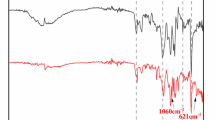Abstract
Denim fabrics are one of the best clothing fabrics worldwide, especially for youngsters. Denim fabric transmission properties have an effect on comfort for the wearer. The air permeability, wicking property, and water vapor permeability properties are the main fabric transmission properties studied in this research. Denim fabrics were manufactured mainly from cotton, but nowadays both spandex and polyester are used in denim production which has a great influence on fabrics’ transmission performance properties. For this study, eight denim fabrics were manufactured. The warp yarn was 100% cotton of 6.5 s count and eight different weft yarns of 100% cotton (10 s), 100% cotton (20 s), cotton/spandex (14 + 70D (5.4% spandex ratio)), cotton/spandex (14 + 70D (2.5% spandex ratio)), polyester/spandex (150 + 40D (12.5% spandex ratio)), polyester/spandex (150 + 40D (10% spandex ratio)), polyester (450D), and polyester (400D). This research aimed to explore the influence of yarn type on denim fabric transmission properties. The result revealed that the spandex ratio has a negative effect on air permeability, vertical wicking, and vapor transmission properties. Fabric A2 showed the highest air permeability (15 cm3/cm2/s) and vapor transmission (48.7%) properties. In the contrary A5 showed the lowest vapor (47.1%) and air transmission (4.5cm3/cm2/s) properties. The ANOVA analysis showed that the air permeability, wicking property, and water vapor permeability of denim fabrics had statistically significant at P values of 0.0, p < 0.05, for all.



Similar content being viewed by others
References
S.H. Eryuruk, The effects of elastane and finishing processes on the performance properties of denim fabrics. Int. J. Clothing Sci. Technol. 31(2), 243–258 (2019)
H.G. Türksoy, N. Yıldırım, and M. Ertek Avcı, Comparative evaluation of some comfort properties of denim fabrics including dual-core yarns containing wool and elastane yarn. J. Text. Inst. , p. 1–8 (2021)
B.F. Adamu, Denim Fabric Surface, Low-stress Tensile and Shear Properties Evaluation based on KES. J. Text. Appare, Technol. Manag. 12(2) (2021)
O. Babaarslan et al., Denim fabrics woven with dual core-spun yarns. Eng. fabrics, p. 19–39 (2018)
B.F. Adamu, B.T. Wagaye, Cotton Contamination, in Cotton Science and Processing Technology: Gene, Ginning, Garment and Green Recycling. ed. by H. Wang, H. Memon (Springer Singapore, Singapore, 2020), pp.121–141
V. Midha, S. Suresh Kumar, M. Nivas Kumar, Investigation on permeability and moisture management properties of different denim fabrics after repeated laundering. J. Text. Inst. 108(1), 71–77 (2017)
T Nicholus, Q.S. ayari Akankwasa, Edwin Kamalha, Llyod Ndlovu, Cotton-elastane ring core spun yarn: A review. (2013)
E. Sarioğlu, O. Babaarslan, A study on physical properties of microfilament composite yarns. J. Eng. Fibers Fabr. 11(3), 155892501601100320 (2016)
N. Mandre, T. Plamus, A. Krumme, Impact of weft yarn density and core-yarn fibre composition on tensile properties, abrasion resistance and air permeability of denim fabrics. Mater. Sci. 27(4), 483–491 (2021)
J. Gao, B. Fentahun, Fashion and Text. 9(8), 10 (2022)
D.Y. Limeneh et al., Efect of weave structure on comfort property of fabric. J. Nat. Fibers 1, 1–8 (2020)
H.A. Kim, Water/moisture vapor permeabilities and thermal wear comfort of the Coolmax®/bamboo/tencel included PET and PP composite yarns and their woven fabrics. J. Text. Inst. 1, 1–14 (2020)
B. Das, N.V. Padaki, K. Jaganathan et al., Comparative studies on thermal comfort properties of eri silk, mulberry silk, wool and linen fibres. J. Inst. Eng. India Series E 102(1), 145–154 (2021)
A.B. Dhouib, S. El-Ghezal, M. Cheikhrouhou, A study of the impact of elastane ratio on mechanical properties of cotton wrapped elastane-core spun yarns. J. Text. Inst. 97(2), 167–172 (2006)
A. Kakvan et al., Effects of draw ratio and elastic core yarn positioning on physical properties of elastic wool/polyester core-spun ring yarns. J. Text. Inst. 98(1), 57–63 (2007)
C.-I. Su, H.-Y. Yang, Structure and elasticity of fine elastomeric yarns. Text. Res. J. 74(12), 1041–1044 (2004)
Özdil, N., Stretch and Bagging Properties of Denim Fabrics Containing Different Rates of Elastane,. FIBRES & TEXTILES in Eastern Europe 208. 16(1).
E. Emine, P. ÇELİK, A research on the parameters of the affecting yarn properties of cotton-polyester rigid core-spun yarns. Text. Apparel 24(2), 195–201 (2014)
T. Bedez Ute, Analysis of mechanical and dimensional properties of the denim fabrics produced with double-core and core-spun weft yarns with different weft densities. J. Text. Inst. 110(2), 179–185 (2019)
N. Uren, A. Okur, Analysis and improvement of tactile comfort and low-stress mechanical properties of denim fabrics. Text. Res. J. 89(23–24), 4842–4857 (2019)
A.K. Choudhary, Ramratan, The influence of yarn and knit structure on moisture management properties of sportswear fabric. J. Inst. Eng. (India) Series E 101(1), 77–90 (2020)
S.H. Eryuruk, Analyzing thermophysiological comfort and moisture management behavior of cotton denim fabrics. Autex Res. J. 21(2), 248–254 (2020)
S. Üstüntağ et al., Optimization of coating process conditions for denim fabrics by taguchi method and grey relational analysis. J. Nat. Fibers 19(2), 685–699 (2022)
ASTM, Standard Test Method for Air Permeability of Textile Fabrics, in ASTM International. 2018: West Conshohocken, PA. p. 5.
BS, Testing fabrics, in Vertical Wicking Test. 2018: London, UK.
ASTM, Standard Test Methods For Gravimetric Determination of Water Vapor Transmission Rate of Materials. 2022: West Conshohocken, PA.
In Vivo Cutaneous and Perceived Comfort Response to Fabric: Part I: Thermophysiological Comfort Determinations for Three Experimental Knit Fabrics. Textile Research Journal 2014.
A. Hajipour, A. Shams Nateri, The effect of weave structure on the quality of inkjet polyester printing. J. Text. Inst. 110(6), 799–806 (2019)
Funding
Not applicable.
Author information
Authors and Affiliations
Corresponding author
Ethics declarations
Conflict interest
The authors declare that they have no known competing financial interests or personal relationships that could have appeared to influence the work reported in this paper.
Additional information
Publisher's Note
Springer Nature remains neutral with regard to jurisdictional claims in published maps and institutional affiliations.
Rights and permissions
Springer Nature or its licensor holds exclusive rights to this article under a publishing agreement with the author(s) or other rightsholder(s); author self-archiving of the accepted manuscript version of this article is solely governed by the terms of such publishing agreement and applicable law.
About this article
Cite this article
Adamu, B.F. Permeability and Moisture Management Properties of Denim Fabric Made from Cotton, Spandex, and Polyester. J. Inst. Eng. India Ser. E 103, 253–258 (2022). https://doi.org/10.1007/s40034-022-00249-1
Received:
Accepted:
Published:
Issue Date:
DOI: https://doi.org/10.1007/s40034-022-00249-1




